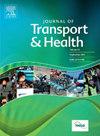A multilevel analysis of urban infrastructure and active commuting in Mumbai: Unraveling the determinants of non-motorized transport
IF 3.3
3区 工程技术
Q2 PUBLIC, ENVIRONMENTAL & OCCUPATIONAL HEALTH
引用次数: 0
Abstract
Introduction
This study aims to explore the intricate relationship between the built environment and active transport within the context of the Global South, utilizing household travel survey data from the Mumbai Metropolitan Region to offer new insights into the complex interactions between urban form and active travel (AT) propensity, frequency, and duration.
Methods
The study focuses on the Mumbai Metropolitan Region, India, one of the nation's most densely populated urban areas. Data were acquired via a household travel survey, compiling demographic specifics, household attributes, and travel logs from 126 households.
Results
Our findings reveal that age, employment status, income, education level, and vehicle ownership significantly impact active travel patterns. The built environment, including factors such as block density, proximity to public transport, and land-use diversity, shows varied effects on active travel propensity, frequency, and duration. Notably, these effects differ between work-related and non-work-related trips, highlighting the importance of considering trip purpose in urban planning and policy-making.
Conclusions
This study provides a comprehensive analysis of active travel behaviour in Mumbai, offering valuable insights for policymakers in emerging economies. By revealing the complex relationships between socio-demographic factors, built environment features, and active travel patterns, this research contributes to the academic discourse on sustainable urban mobility and provides a framework for creating more sustainable, and efficient urban transportation systems in the growing cities of the Global South.
孟买城市基础设施和活跃通勤的多层次分析:揭示非机动交通的决定因素
本研究旨在探索全球南方背景下建筑环境与主动交通之间的复杂关系,利用来自孟买大都市区的家庭旅行调查数据,为城市形态与主动旅行(AT)倾向、频率和持续时间之间的复杂相互作用提供新的见解。方法本研究的重点是印度孟买大都市区,这是印度人口最密集的城市地区之一。数据通过家庭旅行调查获得,收集了126个家庭的人口统计特征、家庭属性和旅行日志。结果年龄、就业状况、收入、受教育程度和车辆拥有量对主动出行模式有显著影响。建筑环境,包括街区密度、接近公共交通和土地利用多样性等因素,对主动出行倾向、频率和持续时间有不同的影响。值得注意的是,这些影响在与工作相关和与工作无关的旅行中有所不同,这突出了在城市规划和政策制定中考虑旅行目的的重要性。本研究对孟买的积极旅游行为进行了全面分析,为新兴经济体的政策制定者提供了有价值的见解。通过揭示社会人口因素、建筑环境特征和主动出行模式之间的复杂关系,本研究有助于可持续城市交通的学术论述,并为在全球南方发展中的城市中创建更可持续、更高效的城市交通系统提供了一个框架。
本文章由计算机程序翻译,如有差异,请以英文原文为准。
求助全文
约1分钟内获得全文
求助全文

 求助内容:
求助内容: 应助结果提醒方式:
应助结果提醒方式:


